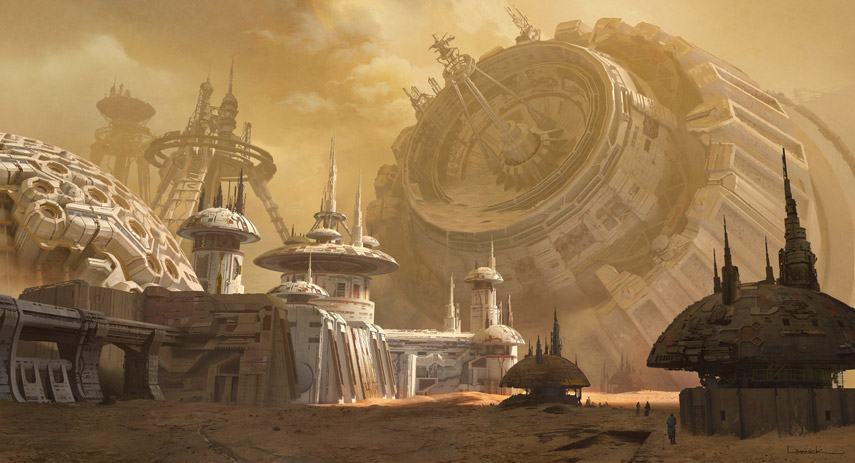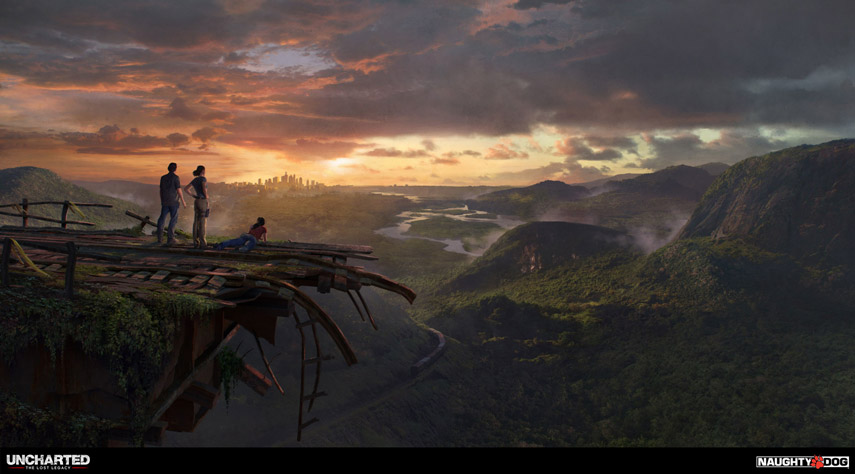Aaron Limonick
 Los Angeles native, Aaron Limonick, has been working as a concept artist for over a decade. While studying illustration and traditional painting at Art Center College of Design, he began gravitating toward the collaborative effort underpinning entertainment products. After contributing to several games at Activision’s Neversoft Entertainment, including developing the original IP, “GUN," he worked for High Moon Studios located in San Diego on multiple Vivendi Universal projects. Limonick’s work can be found in feature films such as Seventh Son, RIPD, Into the Storm, and Jupiter Ascending, and his vast experience also includes working with a variety of studios including LEGO, Disney, Rhythm and Hues, Method Studios, Paramount, 20th Century Fox, and Mirada. Limonick is currently working at Sony with Naughty Dog on projects such as The Last of Us and Uncharted 4: A Thief’s End.
Los Angeles native, Aaron Limonick, has been working as a concept artist for over a decade. While studying illustration and traditional painting at Art Center College of Design, he began gravitating toward the collaborative effort underpinning entertainment products. After contributing to several games at Activision’s Neversoft Entertainment, including developing the original IP, “GUN," he worked for High Moon Studios located in San Diego on multiple Vivendi Universal projects. Limonick’s work can be found in feature films such as Seventh Son, RIPD, Into the Storm, and Jupiter Ascending, and his vast experience also includes working with a variety of studios including LEGO, Disney, Rhythm and Hues, Method Studios, Paramount, 20th Century Fox, and Mirada. Limonick is currently working at Sony with Naughty Dog on projects such as The Last of Us and Uncharted 4: A Thief’s End.
GW: How and when did you decide to make artistry a career instead of solely a hobby?
AL: I have dreamt of being and artist since I was a small child. I had other hobbies and always loved sports and other athletic activities, but I always knew I loved art more than anything else. My parents noticed this and encouraged me to follow my passion and I still thank them to this day for their support and belief. Even though I didn’t know exactly where my journey would take me, or how I would even be able to get a job, I noticed that the people I met who were professional artists seemed to enjoy expressing their visual ideas every day, and that resonated with me.

GW: How did your affinity for environment design, illustration, sketch art, and landscape painting develop? Did one come before the other or did your skill in each develop simultaneously?
AL: I went to school for illustration at Art Center College of Design, here in Los Angeles, and I just naturally started gravitating to certain things during my time there. I think that’s the main benefit to art school. Often when I was young, I would think I knew what I wanted to do, but things became much clearer once I was exposed to new things I wouldn’t have tried on my own. I think I just had a flare for all types of environmental art, and, while I still did character design and a ton of figurative painting and drawing, I wanted to create entire worlds rather than just the inhabitants. Also, seeing all the senior students’ amazing background paintings at Art Center was so inspiring. Everyone there was encouraged to have such unique style to their work at that time, and it became something I desperately wanted to conquer technically and creatively. That same appeal grew stronger when I started seeing art books from animated films and graphic novels; and it was at that point that I realized some people literally spend all day thinking about remarkable fantastic spaces and get paid to do so. This struck a chord with me in a profound way and I never really looked back.

GW: How did you break into the movie industry after starting out in game development?
AL: It sort of happened by accident. I never really set my sights on any particular industry; I just wanted to work on everything, and I had a lot of passion for all genres. Years ago, I began working for a studio called Rhythm and Hues. There, I collaborated on several movies and developed ideas for big VFX shots. I also did some pre-vis for movies that were just ideas at the time, and were still in the greenlight phase. After that, various movie projects would float in from time to time which always brought fun challenges and a change of pace. It was also perfect for my work habits, because when I learn new skills it’s important to me to test them out not only personally but also in a professional situation as well.
GW: You collaborated on projects such as Transformers: War for Cybertron, The Last of Us, and Uncharted. How easy or difficult did you find the work on these projects?
AL: I would say they were all very different and had their own challenges. Cybertron was unique because it was a franchise that was so loved by millions of fans spanning over three decades, but we had never seen this part of the Transformers universe before. Not only that, but we were also aiming to please Hasbro with the new designs, along with Activision, and our internal team. We did this project from start to finish in less than eighteen months total, which is a very short amount of time to create an original universe from scratch with full functioning mechanics. However, creatively, it was so dense with fantastical sci-fi potential that I got to unleash all my childhood dreams.
Working on the Uncharted franchises was vastly fun. It was also a much-loved universe to all the fans and, personally, it called back feelings I got watching Indiana Jones as a kid. It was awesome working on huge set pieces, but each one brought very difficult technical challenges with it. We always try to bring something new and exciting to each project and keep our quality bar high.
As far as The Last of Us is concerned, that was unique because I got to help develop a new universe at Naughty Dog and push the limits of what we could do as a studio. That in itself was like a dream come true. We all felt so proud of what the team created, and it was a very special time to be here. The biggest challenge for me personally was reinventing my whole process and changing my thinking about art in general. Designing alien robots in a stylized, fantastical universe was about the polar opposite from doing super realistic post-apocalypse on Earth. I had to strip out everything I had been doing for the last four years because the habits I had weren’t helping me with the realism required for The Last of Us. I remember working so hard to push myself to make better artistic choices and really think about the efficiency of making each piece, which caused me to learn so much in the end.

GW: In addition to working in the industry, you have also taught at Gnomon. What stands out to you about your time teaching at Gnomon?
AL: I really loved the campus and all the great people working there. I also had the freedom to develop the course to best suit the students, which was very helpful. Since the students at Gnomon are very career driven, I was happy to always share my experience in the industry and try to clarify any myths or concerns people had with getting a job at a studio.
GW: How do you approach creating a concept design or a landscape painting in a new or unfamiliar genre, i.e., fantasy to realism?
AL: I think the key is research in general. The more research I would do, the more I would find out about how to narrow down the ideas visually. I think in this way, it’s one of the more challenging tasks a visual artist can have, but as long as there is a foggy idea of what the end goal could be, it can be clarified over time with enough research and exploration. I would start by collecting a decent amount of reference without too much redundancy, and then continue to reduce the amount down to the essentials. If there are too many references, things can become disorganized and confusing, rather than progressing toward one single direction.

GW: Do you foresee any interesting changes coming about for future breakthroughs in game development and/or the movie industry?
AL: Honestly, I have no idea, but I think the development and applications for VR and AR in education and society are just as interesting as the future for entertainment as a whole. Film seems like its shrinking very quickly, and streaming television is growing rapidly. So, I think there are shifts in how people want to consume their entertainment, but some form of growth and progression is always on the horizon.
GW: What should students and aspiring creators consider about the flux of entertainment industries and changing with the times?
AL: I would say the number one thing is to always try to learn whichever new tools are best at making your job easier. For me, it’s never been about learning every new program just to learn them, but rather deciding which specific ones are best at certain things that will speed me up or bypass a part of the process I specifically don’t enjoy. I find that if there are ways to make work more efficient and open up more time for exploration and design, then that’s the ultimate goal. The race to be the most technically proficient is always going to be there, and, though a slightly less important component for concept artists, it is still very important to acknowledge and not shy away from.
I still focus on how to make better choices in my designs in general and I also spend time to really study other people’s work. I know that may seem like a slightly generic thing to say, but I feel it directly pays off when returning to whatever 3d program of my choice and doing a more complex finished piece. I love dissecting other artists’ work and trying to find out what makes each person so interesting and unique. Rather than copying them, I think they all inspire new ideas, and keep fresh ideas flowing, and that is a bulletproof way to change with the times.

GW: Thank you so much Aaron for the fantastic interview and for taking the time to share your ever-helpful insights and perspectives!
AL: Thanks, Genese, and thanks to Gnomon for including me in so many great events over the years, and I look forward to the future!
| Check out Environment Design and Illustration with Aaron Limonick |






